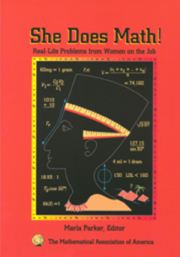Book contents
- Frontmatter
- Preface
- Contents
- Problems by Subject
- Environmental Psychology
- Software Engineering; Computer Science
- Archaeology
- Mathematics and Computer Science
- Civil Engineering
- Mathematics
- Electrical Engineering
- Physics; X-ray Astronomy Research
- Mathematics
- Physics; Astronaut Crew Training Instructor
- Business Data Processing
- Software Engineering; Real Estate Investment
- Quality Engineering
- Health Science
- Nursing Education
- Electrical Engineering; Space Systems
- Oil and Gas Accounting
- Business Administration Higher Education
- Aerospace Engineering
- Structural Engineering
- Computer Science
- Mathematics
- Dietetics—Foodservice Management and Nutrition
- Electrical Engineering
- Chemical Engineering, retired
- Software Engineering
- Immunology and Microbiology
- Mechanical Engineering
- HMO Pharmacy Practice and Management
- Ophthalmology
- Electrical Engineering
- Fish Pathology
- Computer Science and Computer Graphics
- Mathematics and Computing
- Electrical Engineering
- Astronomy
- Author
- Mathematics
- Reflections on WAM
- Solutions
Astronomy
- Frontmatter
- Preface
- Contents
- Problems by Subject
- Environmental Psychology
- Software Engineering; Computer Science
- Archaeology
- Mathematics and Computer Science
- Civil Engineering
- Mathematics
- Electrical Engineering
- Physics; X-ray Astronomy Research
- Mathematics
- Physics; Astronaut Crew Training Instructor
- Business Data Processing
- Software Engineering; Real Estate Investment
- Quality Engineering
- Health Science
- Nursing Education
- Electrical Engineering; Space Systems
- Oil and Gas Accounting
- Business Administration Higher Education
- Aerospace Engineering
- Structural Engineering
- Computer Science
- Mathematics
- Dietetics—Foodservice Management and Nutrition
- Electrical Engineering
- Chemical Engineering, retired
- Software Engineering
- Immunology and Microbiology
- Mechanical Engineering
- HMO Pharmacy Practice and Management
- Ophthalmology
- Electrical Engineering
- Fish Pathology
- Computer Science and Computer Graphics
- Mathematics and Computing
- Electrical Engineering
- Astronomy
- Author
- Mathematics
- Reflections on WAM
- Solutions
Summary
As long as I can remember, I wanted to be an astronomer. In fifth grade, I started an astronomy club among my friends, and proceeded to read every astronomy book I could find in our local library. In high school, I happily took both math courses—geometry and algebra. In college, I majored in astronomy, but also took five years each of math and physics. The only way I managed to get through history and German in my freshman year was because I did not need to spend much time studying math and astronomy. I received a BA in Astronomy from Swarthmore College in 1946, and a PhD in Astronomy from the University of Chicago in 1949.
In my thesis on the Ursa Major Cluster (this cluster includes all but the end stars in the Big Dipper), I studied the motions of many stars to determine which ones were most likely to be members. I used membership in the cluster to determine distances and the brightnesses the stars would have if they were at a standard distance. Then I applied this same method to other clusters, to calibrate the brightnesses of stars from the appearance of their spectra. Astronomers use this method to estimate the distance to stars that are too far away to measure their apparent change in direction as the earth orbits the sun.
- Type
- Chapter
- Information
- She Does Math!Real-Life Problems from Women on the Job, pp. 146 - 151Publisher: Mathematical Association of AmericaPrint publication year: 1995

